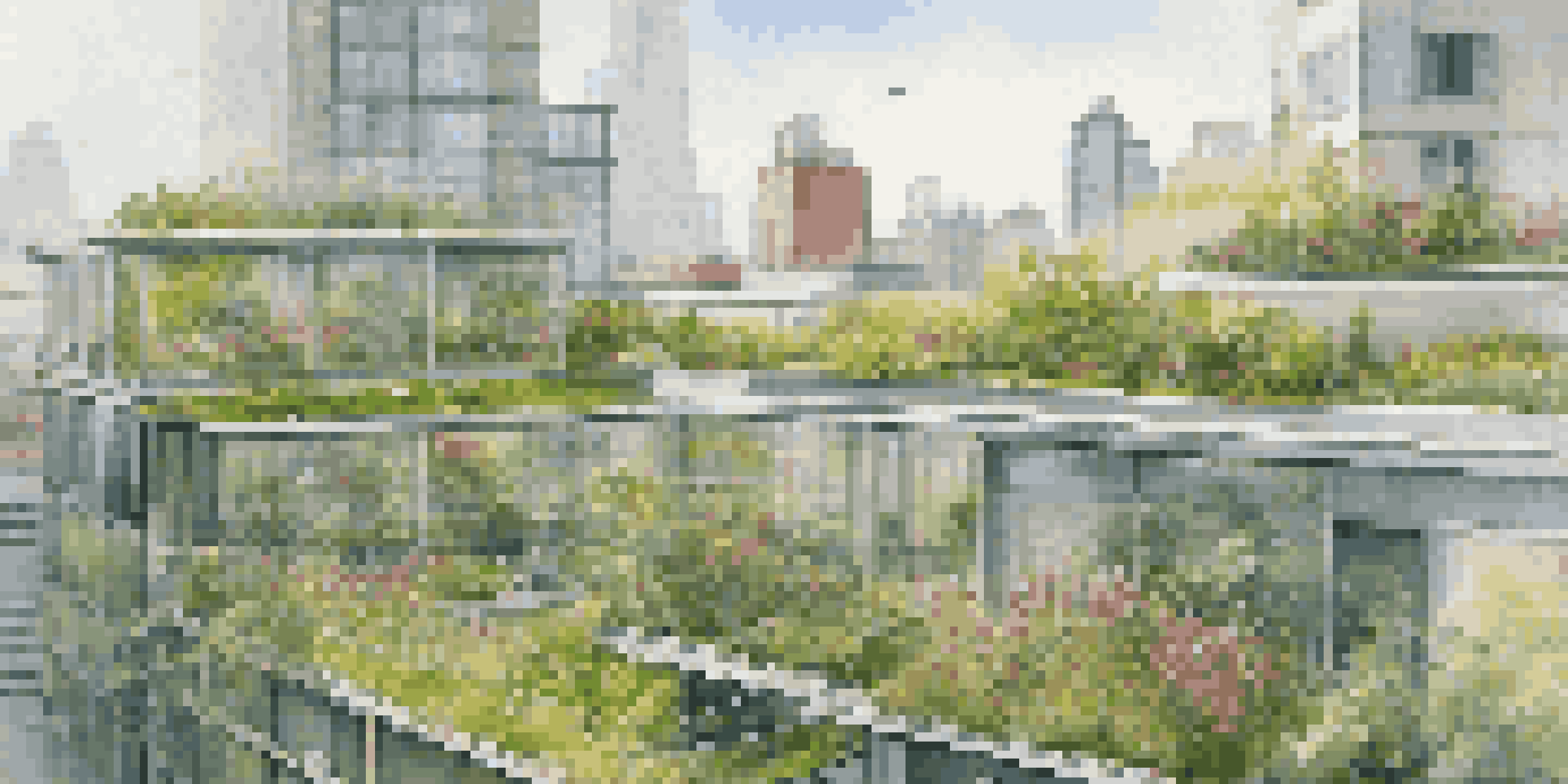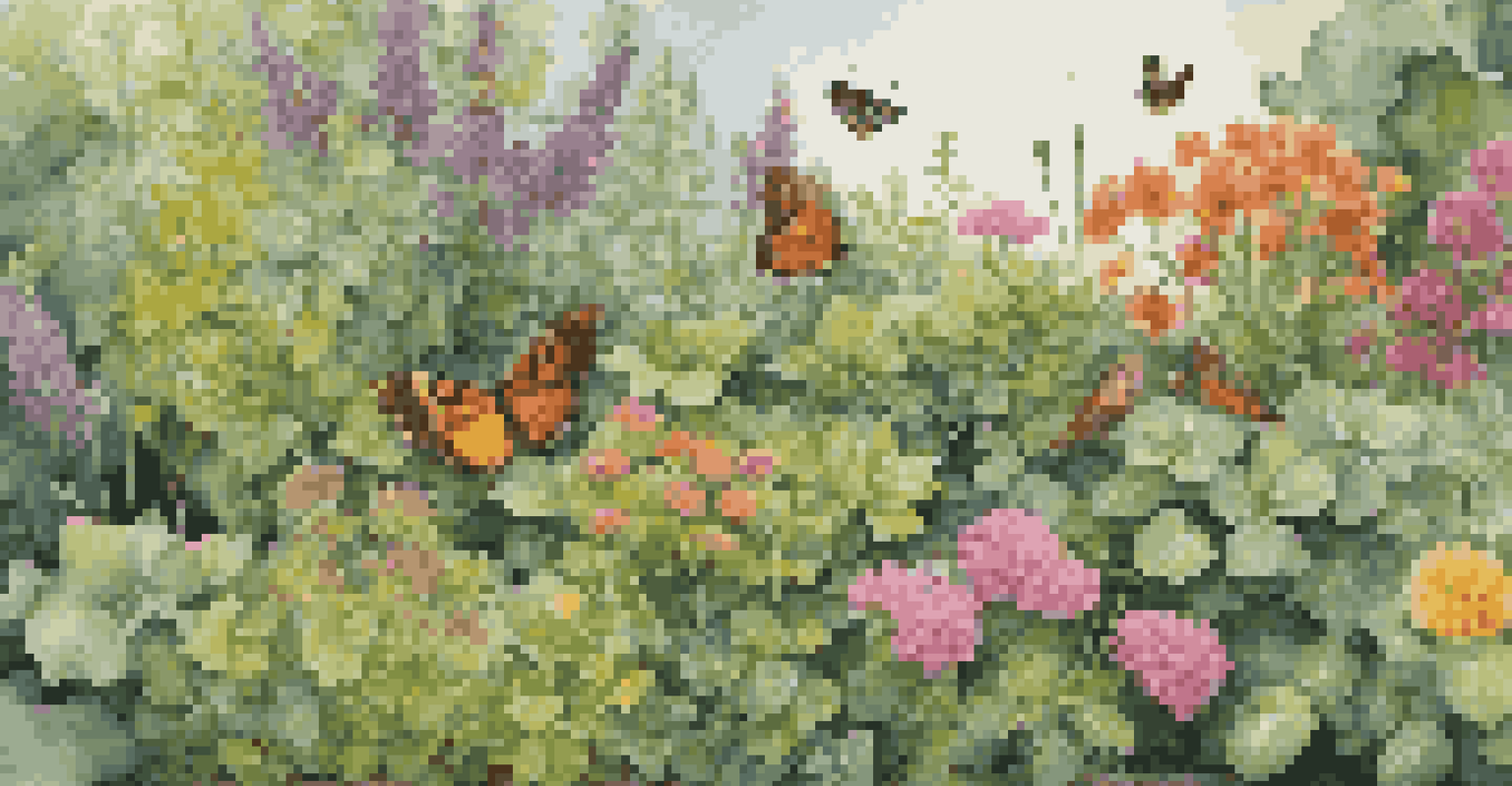The Connection Between Green Roofs and Sustainable Development

What Are Green Roofs and Their Benefits?
Green roofs, often referred to as living roofs, are layers of vegetation planted on rooftops. They serve not only as insulation but also provide numerous environmental benefits. By absorbing rainwater and reducing stormwater runoff, green roofs help manage urban flooding and improve water quality.
The greening of rooftops is a powerful tool for combating climate change and improving urban life.
In addition to environmental advantages, green roofs can significantly enhance urban biodiversity. Birds, insects, and various plant species can flourish in these green spaces, promoting a healthier ecosystem right in the heart of our cities. They also contribute to urban cooling, reducing the heat island effect often experienced in densely populated areas.
Moreover, green roofs can improve air quality by filtering pollutants and carbon dioxide. They act as natural air purifiers, making our cities more breathable and pleasant places to live. This combination of benefits makes green roofs a cornerstone of sustainable urban development.
The Role of Green Roofs in Climate Change Mitigation
As cities expand, they face increasing challenges related to climate change, including rising temperatures and extreme weather events. Green roofs provide a proactive solution by reducing energy consumption, which is crucial in combating climate change. They can lower building temperatures, thereby decreasing the need for air conditioning.

Additionally, green roofs help sequester carbon, which contributes to a reduction in greenhouse gases. These roofs are essentially carbon sinks, absorbing CO2 from the atmosphere and storing it in plant biomass and soil. This process not only helps mitigate climate change but also encourages a healthier urban environment.
By integrating green roofs into urban planning, cities can enhance their resilience to climate impacts. They provide a natural buffer against extreme weather, improving the overall adaptability of urban areas. This makes green roofs an essential component of a sustainable future.
Economic Advantages of Green Roofs
While the initial investment in green roofs can be higher than traditional roofing, the long-term economic benefits are significant. They can extend the lifespan of the roof by protecting it from UV rays and extreme temperature fluctuations. This leads to reduced maintenance and replacement costs over time.
Nature is not a place to visit. It is home.
Moreover, green roofs can increase property values. Properties with green roofs are often more attractive to potential buyers and tenants, as they offer unique outdoor spaces and environmental benefits. This added appeal can translate into higher rental and resale prices.
Green roofs can also provide economic incentives through energy savings. By reducing the energy needed for heating and cooling, building owners can see a noticeable decrease in utility bills. As a result, investing in green roofs can be viewed as a smart financial decision for both residential and commercial properties.
Enhancing Urban Aesthetics with Green Roofs
One of the most visually striking aspects of green roofs is their ability to transform urban landscapes. Rather than being dominated by concrete and asphalt, cities can incorporate lush, green spaces that enhance their overall beauty. This not only improves the visual appeal but also contributes to the mental well-being of residents.
Green roofs offer a unique opportunity for creative design and public art. They can serve as vibrant spaces for community interaction, featuring gardens, walking paths, and even recreational areas. This fosters a sense of community and encourages people to engage with their surroundings.
Furthermore, the presence of greenery can improve the overall atmosphere of a neighborhood. Studies have shown that access to green spaces can lead to lower stress levels and increased happiness among residents. By integrating green roofs into urban development, cities can promote a healthier and more connected community.
Green Roofs and Public Health Benefits
The connection between green spaces and public health is well-documented, and green roofs play a significant role in this relationship. They provide accessible green spaces for physical activity, relaxation, and social interaction, promoting healthier lifestyles. This is particularly important in urban areas where green space can be limited.
Moreover, green roofs can improve mental health by reducing stress and anxiety. The presence of nature has been shown to have calming effects, making green roofs valuable spaces for urban dwellers seeking respite from the hustle and bustle of city life. This connection to nature can help foster a sense of peace and well-being.
Additionally, by filtering air pollutants, green roofs contribute to improved respiratory health. The plants absorb harmful particles and release oxygen, creating cleaner air for residents. As urban populations grow, the health benefits of green roofs become increasingly essential in promoting public health.
Policy and Incentives for Green Roof Implementation
To fully harness the benefits of green roofs, supportive policies and incentives are crucial. Governments can promote green roofs through zoning regulations and building codes that encourage or even require their installation. This can significantly boost their adoption in urban development projects.
Incentive programs, such as tax credits or grants for building owners, can also encourage investment in green roofs. By making the financial burden lighter, more property owners may consider integrating these sustainable solutions. This not only contributes to environmental goals but also stimulates local economies.
Public awareness campaigns highlighting the benefits of green roofs can further drive interest and acceptance. Educating the community on the environmental, economic, and health benefits can foster a culture of sustainability that encourages more individuals and businesses to participate in green roofing initiatives.
Challenges in Adopting Green Roof Technology
Despite their benefits, the adoption of green roofs faces several challenges. One major hurdle is the upfront cost, which can deter property owners from making the investment. While the long-term savings are compelling, the initial expense can be a significant barrier for many, especially in economically strained areas.
Another challenge is the lack of knowledge and expertise in green roof installation and maintenance. Many builders and contractors may not have the necessary experience to properly execute these projects, leading to subpar results. This can result in a perception that green roofs are impractical or unreliable.

Lastly, regulatory hurdles can complicate the implementation of green roofs. In some regions, building codes may not adequately support or promote green roofing technologies. Addressing these challenges through education, policy changes, and financial incentives is essential for broader adoption.